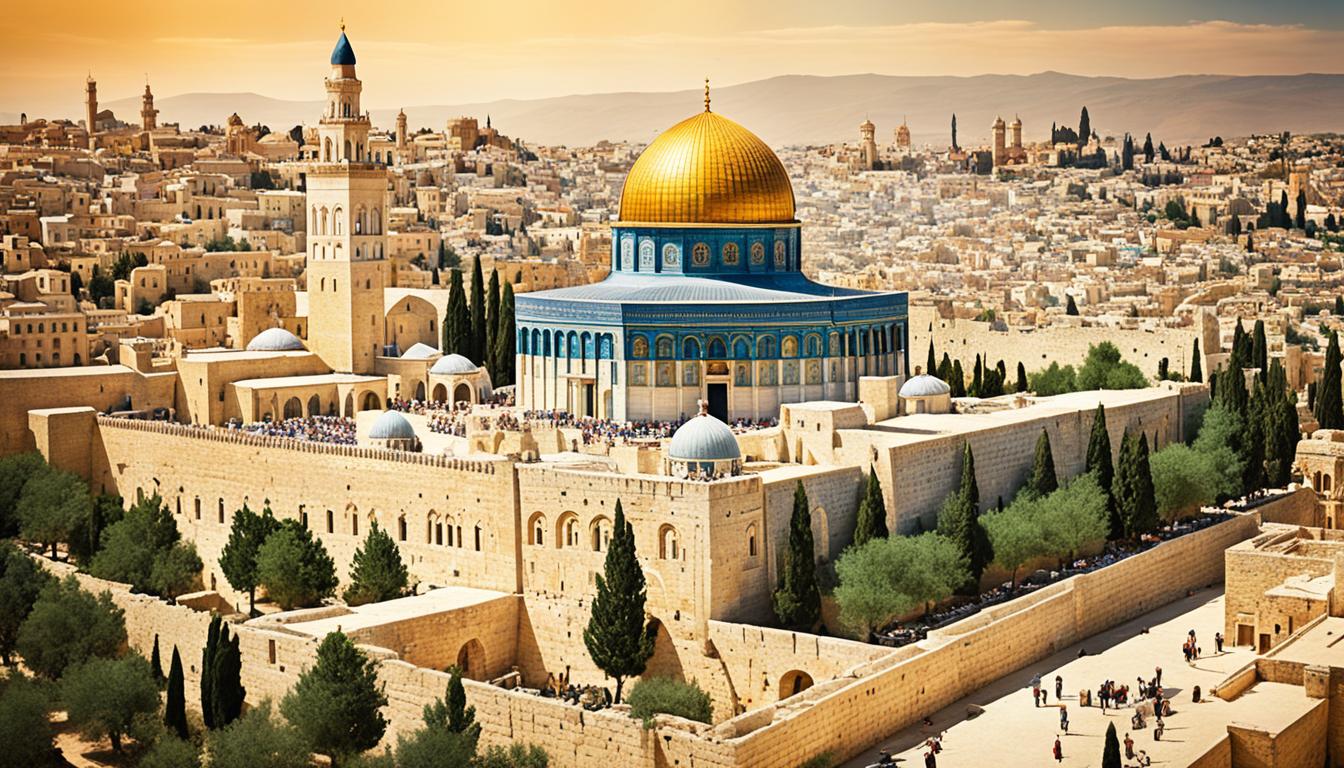In biblical times, there were numerous major cities that played significant roles in history and culture. These cities are mentioned in various scriptures and have left a profound impact on the religious and historical narratives of that era.
Key Takeaways:
- During biblical times, there were prominent cities that held great significance in the Bible.
- These ancient cities were mentioned in scriptures and played crucial roles in biblical narratives.
- Capernaum, Jerusalem, Joppa, Caesarea, and cities of refuge were among the major cities during biblical times.
- Jerusalem holds immense religious and historical significance as the city where Jesus completed His mission.
- The cities of refuge provided sanctuary for those accused of unintentional manslaughter.
Capernaum – The City of Convergence
Capernaum, located on the northwestern tip of the Sea of Galilee, was a bustling fishing town and commercial center during biblical times. It was chosen by Jesus as the base for His ministry due to its strategic location and the presence of His future disciples Peter and Andrew. The city’s proximity to major trade routes ensured that Jesus’ teachings and miracles could be spread quickly to other significant cities in the region.
Capernaum was not only a hub for commerce but also a place where people from various backgrounds converged. Its location on the Sea of Galilee made it accessible to both Jewish and Gentile communities, allowing Jesus to reach a diverse audience with his messages of love, healing, and salvation.
“And leaving Nazareth, he went and lived in Capernaum by the sea, in the territory of Zebulun and Naphtali.” – Matthew 4:13
The city of Capernaum served as a significant backdrop for many well-known biblical events. It was in Capernaum that Jesus performed numerous miracles, including healing the paralytic, casting out demons, and raising the daughter of Jairus from the dead. These remarkable occurrences solidified Capernaum’s place in history as a city intimately connected to the life and ministry of Jesus.
The archaeological remains of Capernaum, including the site of an ancient synagogue believed to be the one where Jesus taught, provide a glimpse into the city’s vibrant past. Today, visitors can explore the ruins and witness firsthand the convergence of ancient history and biblical narratives.
Capernaum – Key Highlights
| Key Event/Feature | Description |
|---|---|
| Miracles of Healing | Jesus performed several healing miracles in Capernaum, demonstrating His power and compassion. |
| Centurion’s Servant | Jesus healed the centurion’s servant, showcasing His authority and ministry extending to Gentiles. |
| The Calling of Peter and Andrew | Jesus called Peter and Andrew, two fishermen from Capernaum, to become His disciples. |
| House of Peter | Traditionally recognized as the place where Jesus stayed while in Capernaum, it became a center for gathering and teaching. |
Jerusalem – The City of Completion
Jerusalem, one of the most revered cities in biblical history, holds immense religious and historical significance. It is the city where Jesus completed His mission on Earth, fulfilling His purpose as the Messiah.
In Jerusalem, Jesus faced pivotal events that shaped His journey. It was here that He experienced the triumphal entry, hailed by crowds as the King of Kings. The city also witnessed the Last Supper, where Jesus shared His final meal with His disciples before His crucifixion.
The trial of Jesus before Pontius Pilate took place in Jerusalem, marking a critical moment in His narrative. The city became the backdrop for His crucifixion, an event that changed the course of history and served as the ultimate act of sacrifice for humanity.
However, Jerusalem’s significance does not end with Jesus’ death. It was also in this city that He rose from the dead, conquering death and offering salvation to all who believe in Him. This resurrection became the cornerstone of the Christian faith.
“And if Christ has not been raised, your faith is futile; you are still in your sins.” – 1 Corinthians 15:17
Jerusalem’s role in biblical history goes beyond the life of Jesus. It was a sacred city for the Jewish people, home to the First and Second Temples, which were central to their worship and religious practices.
Visiting Jerusalem today allows believers to walk in the footsteps of Jesus, experiencing firsthand the places where key moments in His life occurred. It is a city that invites reflection, devotion, and a deeper understanding of the profound impact of the biblical narrative.

The Significance of Jerusalem:
- Jerusalem is where Jesus completed His mission on Earth, fulfilling the role of the Messiah.
- Key events in Jesus’ life took place in Jerusalem, including the triumphal entry, the Last Supper, and His trial before Pontius Pilate.
- The crucifixion and resurrection of Jesus occurred in Jerusalem, serving as the foundation of the Christian faith.
- Jerusalem was a sacred city for the Jewish people, housing the First and Second Temples.
Joppa – The City of Correction
In ancient times, Joppa was a significant coastal city located along the shores of the Mediterranean Sea. Known for its bustling harbor and strategic location, Joppa played a pivotal role in biblical narratives and the spread of Christianity.
A notable event that took place in Joppa is the transformative experience of the apostle Peter. It was in this city that Peter received a vision from God, correcting his previous understanding of the Gospel’s reach. This vision revealed that the message of salvation was meant for both Jews and Gentiles, breaking down barriers and expanding the influence of Christianity beyond its Jewish roots.
“While Peter was in Joppa, he fell into a trance and saw a vision. In this vision, a sheet came down from heaven filled with all kinds of animals. A voice told Peter to kill and eat, disregarding the Jewish dietary laws. This vision challenged Peter’s beliefs and prepared him for the inclusion of Gentiles in the faith.”
The impact of Peter’s vision in Joppa was profound. It marked a turning point in early Christianity and paved the way for the spread of the Gospel to diverse communities. The inclusion of Gentiles in God’s plan of salvation brought unity and diversity to the growing Christian movement.

Joppa remains a significant city in biblical history, symbolizing the correction of biases and the embrace of God’s inclusive love.
Key Points:
- Joppa was an important coastal city in ancient times.
- Peter received a vision in Joppa, revealing that the Gospel was meant for both Jews and Gentiles.
- This vision played a pivotal role in the spread of Christianity beyond the Jewish community.
Caesarea – The City of Confession
Caesarea, built by Herod the Great to honor Caesar Augustus, was a Roman capital located on the coast of the Mediterranean Sea. This ancient city played a significant role in biblical times, particularly in the expansion of early Christianity. One of the most notable events that occurred in Caesarea was the encounter between the Roman centurion Cornelius and the Apostle Peter.
In his vision from God, Cornelius was instructed to send for Peter, who was in the nearby city of Joppa. This divine encounter marked a turning point in the acceptance of Gentiles into the Christian faith. Peter’s visit to Caesarea resulted in the conversion of Cornelius and his household, highlighting the inclusivity of God’s plan and breaking down barriers between Jews and Gentiles.
“Then Peter opened his mouth and said: ‘In truth I perceive that God shows no partiality. But in every nation whoever fears Him and works righteousness is accepted by Him.’” – Acts 10:34-35
The confession of faith made by Cornelius and his household in Caesarea became a significant milestone in the early spread of Christianity beyond the Jewish community. It demonstrated that God’s love and salvation were not limited to a specific group of people, but extended to all who believed in Him.

The Importance of Caesarea in Biblical Times
Caesarea played a crucial role as a Roman capital and a prominent city in biblical narratives. Besides its association with the conversion of Gentiles, Caesarea also served as a center for early Christian activities, including the ministry of the Apostle Paul. The city is mentioned multiple times in the New Testament, showcasing its significance in the spread of Christianity.
In addition to its religious importance, Caesarea was renowned for its architectural marvels and grandeur. It boasted a massive harbor, palaces, temples, and an amphitheater, showcasing the opulence and power of the Roman Empire. Today, the archaeological remains of Caesarea stand as a testimony to its historical and biblical significance.
Cities of Refuge
Six cities in ancient Israel served as cities of refuge, offering sanctuary to individuals accused of unintentional manslaughter. These cities, including Kadesh, Shechem, and Hebron, were strategically located across the country to ensure access from various regions. The concept of cities of refuge aimed to uphold the principles of justice and protection in biblical society.
When someone unintentionally caused the death of another person, they could flee to one of the cities of refuge for safety. These cities provided a place of refuge until they could stand trial and prove their innocence or establish that the death was unintentional.
The cities of refuge played a crucial role in preventing blood feuds and promoting fair trials. They were established as safe havens where individuals could find temporary relief from the consequences of their actions, allowing them the opportunity to seek justice and redemption.
“Whoever kills any person accidentally may flee there and find protection from the avenger of blood.” – Numbers 35:11
The cities of refuge not only served as protective shelters but also enabled individuals to find refuge and solace in their communities. Their establishment reflected the value placed on compassion, mercy, and the preservation of life within the ancient Israelite society.
Cities of Refuge in Ancient Israel
| City | Tribe | Location |
|---|---|---|
| Kedesh | Naphtali | Northern Israel |
| Shechem | Ephraim | Central Israel |
| Hebron | Judah | Southern Israel |
| Bezer | Reuben | Eastern Israel |
| Ramoth | Gad | Eastern Israel |
| Golan | Manasseh | Northern Israel |
These cities were strategically situated to provide fair access to refuge across different regions, allowing fugitives to find safety and fair judgment. The concept of cities of refuge in ancient Israel demonstrates the importance of mercy, compassion, and the pursuit of justice in biblical times.

Levitical Cities
The Levites, a tribe set apart for religious duties, were assigned specific cities throughout ancient Israel. These Levitical cities played a vital role in the religious and social fabric of the Israelite community. They served as centers for worship, education, and providing support in matters relating to religious instruction, sacrifices, and legal disputes.
Some of the prominent Levitical cities mentioned in the Bible include:
- Anathoth
- Bethel
- Mizpah
- Jerusalem (including specific areas allotted to Levites)
The Levites, known for their dedication to serving God and preserving religious traditions, resided in these cities to fulfill their responsibilities. They played a crucial role in leading the Israelite community in matters of worship, teaching the law, and maintaining religious order.
“And the Levites, who do not share in the priestly service with their fellow Levites, are appointed by God to serve as ministers in their assigned cities and towns.” – Numbers 35:7
These Levitical cities were strategically distributed throughout different regions of Israel, ensuring that every Israelite had access to religious guidance and support. They served as a unifying force, helping the Israelites stay connected to their faith and maintaining the spiritual well-being of the community.
Furthermore, the Levitical cities provided a sense of security and justice. In addition to their religious duties, the Levites acted as judges and mediators, resolving disputes among the Israelites in accordance with God’s law.
Overall, the Levitical cities were significant centers of religious and social life in ancient Israel. They exemplified the importance of religious education, worship, and communal support, playing a crucial role in preserving the faith and traditions of the Israelite people.
| Levitical City | Location | Main Role |
|---|---|---|
| Anathoth | Located in the territory of Benjamin, near Jerusalem | Home of the prophet Jeremiah |
| Bethel | Located north of Jerusalem in the territory of Benjamin | Sacred place of worship and prophetic activity |
| Mizpah | Located in the region of Benjamin, northeast of Jerusalem | Site of important gatherings, religious ceremonies, and legal proceedings |
| Jerusalem | Located in the territory of Benjamin | Central hub for worship and administration of religious affairs, including the Temple |
Ancient Cities Mentioned in the Bible
The Bible is replete with references to various ancient cities that played significant roles in biblical narratives. These cities witnessed miracles, battles, and the fulfillment of prophecies, leaving an indelible mark on the religious and historical narrative of that time.
Among the notable cities mentioned in the Bible are:
- Ai: This ancient Canaanite city was conquered by the Israelites under Joshua’s leadership, demonstrating the fulfillment of God’s promise to give them victory.
- Ashdod: A key Philistine city and one of the five major cities of the Philistine Pentapolis, mentioned in the context of conflicts with the Israelites.
- Bethlehem: The birthplace of King David and Jesus Christ, Bethlehem holds immense significance in both the Old and New Testaments.
- Jericho: Famous for the miraculous fall of its walls during the Israelite conquest, Jericho serves as a testament to God’s power and faithfulness.
- Nineveh: The capital of the Assyrian empire, Nineveh is mentioned in the story of Jonah, who was sent to prophesy against the city and witnessed its subsequent repentance.
These cities each have their own historical and cultural significance and contribute to the rich tapestry of biblical narratives. The stories associated with these ancient cities provide deep insights into the faith, struggles, and triumphs of the people who inhabited them.
“Ai, Ashdod, Bethlehem, Jericho, and Nineveh—these ancient cities have shaped the biblical narrative, bearing witness to the wonders and divine plans laid out throughout history.”
Explore the profound stories embedded within these ancient cities, and delve into the wonders of their historical and religious significance.
The Miracle of Jericho
The city of Jericho is known for its remarkable story of redemption and faith. The Israelites, led by Joshua, obediently followed God’s instructions to conquer the heavily fortified city. By marching around Jericho for seven days and blowing trumpets, the walls came tumbling down, marking a miraculous victory for the Israelites.
| City | Significance |
|---|---|
| Ai | Conquered by the Israelites under Joshua’s leadership |
| Ashdod | One of the key Philistine cities |
| Bethlehem | The birthplace of King David and Jesus Christ |
| Jericho | Famous for the miraculous fall of its walls |
| Nineveh | The capital of the Assyrian empire |
These ancient cities hold stories of faith, conquest, and redemption, continuing to inspire and guide readers of the Bible to this day.

Conclusion
The major cities in biblical times hold immense historical and religious importance. These ancient cities mentioned in the Bible played pivotal roles in the life and teachings of Jesus, as well as in the early spread of Christianity. From Capernaum, where Jesus began His ministry, to Jerusalem, where His mission was completed, these cities bear witness to significant events that shaped the course of human history.
Capernaum, located on the northwestern tip of the Sea of Galilee, served as a strategic hub for Jesus’ ministry. It was here that Jesus chose His disciples, performed miracles, and delivered powerful teachings. Jerusalem, on the other hand, is synonymous with some of the most defining moments in Jesus’ life and the fulfillment of prophecy. The city witnessed His crucifixion, resurrection, and triumphal entry, etching its name in the annals of Christianity forever.
Joppa and Caesarea, though smaller in scale, played integral roles in the early expansion of Christianity. Joppa was the place where the apostle Peter underwent a transformative experience, receiving a divine vision that opened the door to the incorporation of Gentiles into the faith. Caesarea, a Roman capital built by Herod the Great, was a key site where Gentiles first embraced Christianity, leading to its subsequent worldwide spread.
The major cities in biblical times not only serve as essential landmarks in religious history but also highlight the influence of scriptures on culture and society. These ancient cities are testaments to the enduring impact of the Bible and its teachings, resonating with believers and scholars alike to this day.
FAQ
What were some major cities in biblical times?
Some major cities in biblical times include Capernaum, Jerusalem, Joppa, Caesarea, and many others.
Why was Capernaum significant in biblical times?
Capernaum was significant in biblical times because it served as a base for Jesus’ ministry and was strategically located for spreading His teachings.
What is the historical and religious significance of Jerusalem?
Jerusalem holds immense historical and religious significance as the city where Jesus completed His mission on Earth, including His crucifixion and resurrection.
What happened in Joppa that was significant in biblical times?
In Joppa, the apostle Peter received a vision from God, which led to the inclusion of Gentiles in the Christian faith.
How did Caesarea contribute to the early spread of Christianity?
Caesarea was the city where the Roman centurion Cornelius received a vision from God, leading to the acceptance of Gentiles into the Christian faith.
What were the cities of refuge in biblical times?
The cities of refuge were designated cities that provided sanctuary for individuals accused of unintentional manslaughter.
Why were Levitical cities important in biblical times?
Levitical cities served as centers for religious worship and education, housing the Levites and supporting the Israelite community in matters of religion and law.
What are some other ancient cities mentioned in the Bible?
Other ancient cities mentioned in the Bible include Ai, Ashdod, Bethlehem, Jericho, and Nineveh, each with their own historical and cultural significance.
How do major cities in biblical times contribute to history and culture?
Major cities in biblical times hold immense historical and religious importance, shaping the narratives of the Bible and leaving a lasting impact on history and culture.







